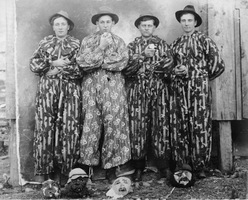 | Back to e-WV
| Back to e-WV
 The West Virginia Encyclopedia
The West Virginia Encyclopedia
 | Back to e-WV
| Back to e-WV
 The West Virginia Encyclopedia
The West Virginia Encyclopedia

Belsnickling, once common in parts of West Virginia, is an ancient mid-winter practice related to many similar winter solstice activities found in western countries. Of German origin, belsnickling is similar to mumming traditions as found in Anglo-Celtic countries (England, Scotland, Ireland). The term is an Anglicized version of two German words: Pels (fur) and Nicholas (St. Nicholas). Over time, pels Nicholas came to be pronounced belsnickle, and it simply means a furry St. Nicholas.
The practice of belsnickling (also called ‘‘pelsing’’) in West Virginia involves a group, dressed in masquerade, going from house to house visiting neighbors and having the inhabitants guess who they are. Sometimes mischief is involved, and often the belsnickles were given seasonal treats such as cider and cake. Some older people remember that they, as belsnickles, carried a switch and switched the hands of children who reached for the candy they offered. The belsnickle figure sometimes represented this darker presence, and it was common for parents to warn children to ‘‘be good or the belsnickle will get you.’’ Belsnickling is rare in West Virginia today, but until the mid-20th century it was common in areas of early German settlement in the eastern side of the state.
Written by Gerald Milnes
Barrick, Mac. E. German-American Folklore. Little Rock: August House, 1987.
Cline, Ruth H. Belsnickles and Shanghais. Journal of American Folklore, (April-June 1958).
Milnes, Gerald C. Old Christmas and Belsnickles. Goldenseal, (Winter 1995).